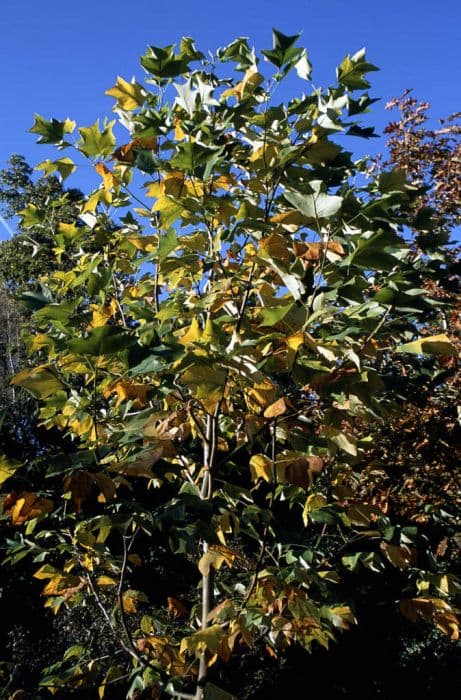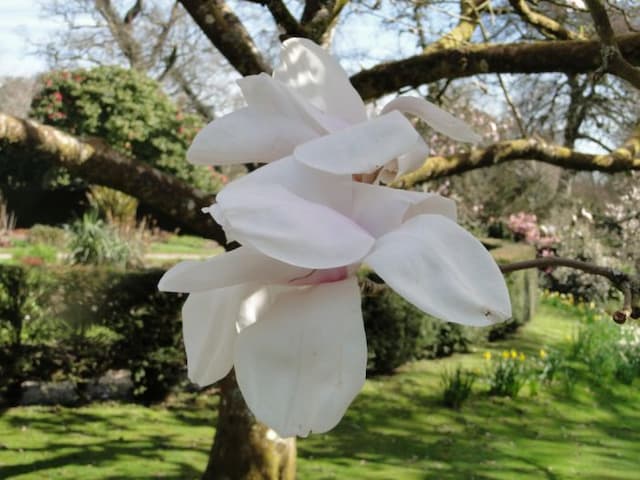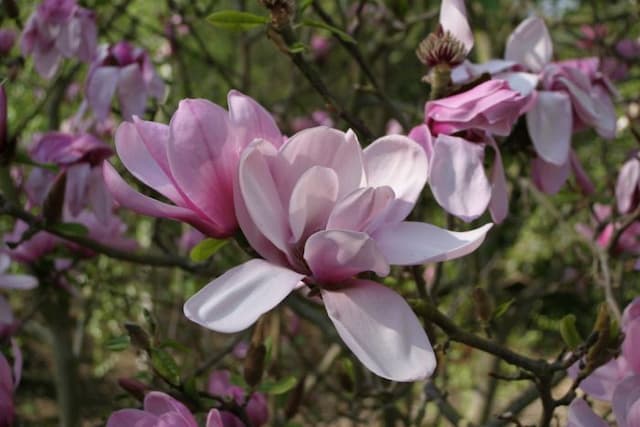Banana Shrub Magnolia figo

ABOUT
Magnolia figo, commonly known as the Banana Shrub, features a glossy, evergreen appearance with leaves that are leathery to the touch. The foliage is generally dark green and provides a lush backdrop for its charming flowers, which are small and creamy to pale yellow in color. These blossoms exude a sweet, banana-like fragrance, hence the common name. The petals of the flowers are thick and waxy, sometimes edged with a slight hint of purple or maroon. This plant exhibits a bushy growth habit with a dense branching structure, giving it a full and rounded appearance. The Banana Shrub's overall look is one that is both tropical and elegant, making it a favorite choice for ornamental gardens where it can be appreciated for its aromatic flowers and robust foliage.
About this plant
 Names
NamesFamily
Magnoliaceae.
Synonyms
Banana Shrub, Port Wine Magnolia, Banana Magnolia.
Common names
Magnolia fuscata, Michelia fuscata, Liriodendron figo, Magnolia figo var. crassipes, Michelia figo.
 Toxicity
ToxicityTo humans
Magnolia figo, commonly known as Banana Shrub, is not considered to be toxic to humans. There are no widespread reports of poisoning from ingesting any parts of this plant. However, it is generally advisable to avoid consuming parts of ornamental plants due to the potential risk of gastrointestinal discomfort or other non-specific symptoms.
To pets
Banana Shrub is also not known to be toxic to pets. There is no significant evidence to suggest that ingestion of parts of this plant by pets such as dogs or cats results in poisoning. Nonetheless, it is always recommended to monitor pets and prevent them from eating plants as a precautionary measure.
 Characteristics
CharacteristicsLife cycle
Perennials
Foliage type
Evergreen
Color of leaves
Green
Flower color
Creamy-white
Height
10-15 feet (3-4.5 meters)
Spread
6-8 feet (1.8-2.4 meters)
Plant type
Shrub
Hardiness zones
7-9
Native area
China
Benefits
 General Benefits
General Benefits- Aesthetic appeal: Magnolia figo, also known as Banana Shrub, produces attractive, glossy green leaves and fragrant flowers that resemble small magnolias, enhancing the visual beauty of gardens and landscapes.
- Fragrance: The flowers emit a sweet, banana-like fragrance, which can be enjoyed in the garden or from cut flowers indoors.
- Landscape versatility: Banana Shrub can be used in a variety of landscape applications, such as specimen planting, hedges, and foundation plantings, making it a versatile choice for gardeners.
- Shade provision: With its dense foliage, it provides shade and can help create a cooler microclimate in the garden during hot weather.
- Wildlife attraction: Banana Shrub can attract pollinators like butterflies and bees, which are essential for the pollination of plants and the overall health of the garden ecosystem.
- Low maintenance: Once established, Magnolia figo is relatively low maintenance, requiring only basic care like occasional pruning and watering during extreme droughts.
- Drought tolerance: It can tolerate periods of dry weather once established, making it suitable for regions with occasional water scarcity.
 Medical Properties
Medical Properties- Antimicrobial: Magnolia figo extracts have been found to possess antimicrobial properties against certain pathogens.
- Anti-inflammatory: The plant may exhibit anti-inflammatory effects, potentially reducing inflammation in some conditions.
- Antioxidant: Magnolia figo contains compounds that have been shown to exhibit antioxidant properties.
- Anxiolytic effects: Some studies suggest that compounds in Magnolia figo may have a calming effect, which could help with anxiety.
- Neuroprotective: There is some evidence that suggests the potential for neuroprotective effects from extracts of the plant.
- Anti-cancer: Limited studies have explored the anti-cancer potential of this plant's compounds in vitro.
 Air-purifying Qualities
Air-purifying QualitiesThis plant is not specifically known for air purifying qualities.
 Other Uses
Other Uses- Magnolia figo can be used as a natural fabric dye, lending a subtle greenish hue to textiles when the leaves or bark are processed.
- Its wood is occasionally utilized in fine woodworking for inlays or small objects, appreciated for its fine grain and workability.
- In some cultures, the fragrant blossoms may be used as a natural perfume or to scent rooms when placed in a bowl of water.
- The dried leaves of Magnolia figo have been incorporated into potpourri mixes for a long-lasting, sweet fragrance.
- Florists use the branches and flowers of Magnolia figo in floral arrangements to add an exotic and fragrant touch.
- Gardeners value the plant for companion planting as it can attract pollinators like bees and butterflies to gardens.
- The plant's thick leaves can be used in minor crafting projects, such as creating natural bookmarks or decorative elements.
- In some regions, the flowers of Magnolia figo are candied and used as edible decorations on desserts.
- The essential oils derived from Magnolia figo can be used in the making of scented candles, offering a natural room fragrance.
- Because of its dense foliage, Magnolia figo can be planted as a privacy hedge in residential gardens or around patios.
Interesting Facts
 Feng Shui
Feng ShuiThe plant_name is not used in Feng Shui practice.
 Zodiac Sign Compitability
Zodiac Sign CompitabilityThe plant_name is not used in astrology practice.
 Plant Symbolism
Plant Symbolism- Perseverance and Durability - Magnolia figo, also known as Banana Shrub, is known for its hardy nature and ability to withstand tough conditions, symbolizing the resilience and strength to persevere through challenges.
- Nobility - In some cultures, magnolias are associated with nobility and dignity, due to their impressive appearance and stature.
- Feminine Beauty - The delicate and fragrant blooms of the Banana Shrub are often seen as a representation of feminine grace and beauty.
- Love of Nature - With its lush foliage and sweet-smelling flowers, Magnolia figo is a symbol of the deep appreciation for the natural world.
- Peace and Tranquility - The soothing scent of the Banana Shrub's flowers is said to promote a sense of calm and peace, making it a symbol of tranquility.
 Water
WaterBanana Shrub should be watered deeply, allowing the soil to dry out slightly between waterings. During the active growth period in spring and summer, this might mean watering every week with about 1 to 1.5 gallons of water, depending on the size of your shrub and the environmental conditions. In the winter months, reduce watering frequency to once every two to three weeks, as the plant's water requirements decrease. Always check the top few inches of soil for moisture before watering to avoid over-watering, which can lead to root rot.
 Light
LightBanana Shrub thrives best in full sun to partial shade. An ideal spot is where the plant can receive morning sunlight and afternoon shade, especially in hotter climates. Avoid deep shade as it can lead to a reduction in the number of blooms and can cause the plant to grow leggily.
 Temperature
TemperatureBanana Shrub prefers a moderate to warm climate, ideally between 60°F and 80°F. The plant can tolerate minimum temperatures down to about 20°F, but frost can damage the leaves and flowers. It is crucial to protect the Banana Shrub from extreme cold or high winds that can harm the plant.
 Pruning
PruningBanana Shrub should be pruned for shape, size control, and removal of any damaged or dead branches. The best time for pruning is after the plant has finished blooming in late spring or early summer. Light pruning annually or biennially is sufficient to maintain a tidy appearance and encourage healthy growth.
 Cleaning
CleaningAs needed
 Soil
SoilBanana Shrub requires well-draining soil with a mildly acidic to neutral pH between 5.5 and 7.0. A soil mix composed of two parts loam, one part peat, and one part sand or perlite is ideal to ensure adequate drainage and fertility for healthy growth.
 Repotting
RepottingBanana Shrub does not require frequent repotting and can be repotted every 2-3 years. It's best to repot in the spring before the onset of the new growth season.
 Humidity & Misting
Humidity & MistingBanana Shrub thrives in moderate to high humidity levels, generally preferring humidity levels between 50-60%. However, it can tolerate lower humidity if necessary.
 Suitable locations
Suitable locationsIndoor
Provide bright, indirect light and keep soil moist.
Outdoor
Choose a sunny to partly shaded spot; water regularly.
Hardiness zone
7-10 USDA
 Life cycle
Life cycleThe life of a Banana Shrub (Magnolia figo) begins with seed germination, sparked by warmth and moisture in the soil, usually taking place in spring. It progresses to the seedling stage as the young plant develops roots and shoots, subsequently growing its characteristic glossy, evergreen leaves. As the plant matures, it enters the vegetative stage, where it experiences significant growth and branching. Upon reaching maturity, the Banana Shrub enters the flowering stage, typically in spring, producing creamy-yellow, purple-blushed flowers that release a banana-like fragrance. Following pollination, fruits develop which contain seeds, completing the reproductive cycle. These seeds, once dispersed, can give rise to new plants, perpetuating the species.
 Propogation
PropogationPropogation time
Spring-Early Summer
The most popular method of propagation for Magnolia figo, commonly known as Banana Shrub, is through semi-hardwood cuttings. This method is typically done in late summer when the plant's growth begins to slow. Cuttings should be taken from new growth that is just beginning to harden off. These cuttings, usually about 4 to 6 inches (10 to 15 centimeters) long, should have several sets of leaves. The lower leaves are removed, and the cut end is dipped in a rooting hormone before being placed into a well-draining potting mix. The cuttings should be kept moist and in a warm environment with indirect light until roots have developed, which can take several weeks. Once rooted, the young plants can be gradually acclimatized to outside conditions and then planted in their permanent location.









![Magnolia [Felix Jury]](/_next/image?url=https%3A%2F%2Fplants-admin.emdemapps.com%2Fimages%2Fplants%2F%2Fimages%2F604b61a0b23b7.png&w=640&q=75)